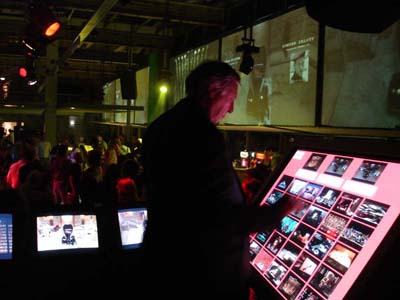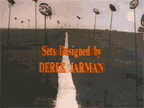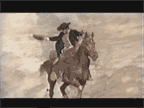
members: Peter Greenaway
Emerging from a long, focused, and rigorous filmmaking background, Peter Greenaway has expanded his plastic inquiries to a new plane, shattering the very foundations of the primary medium he has worked with for over 45 years. His restless spirit had been has been making signs of this transformation over the past decade through installation work and through the increasingly challenging narrative structures in his films. So in many ways this was a logical next step for Greenaway.
At this point, "VJ Greenaway" or "vampler Greenaway" uses an impressive interface consisting of a large plasma touch screen, enabling him to trigger shots to any number of screens (6 at Enghien-les-Bains 2009, 12 displays at the Club11 in Amsterdam...) - the audio as well. "The system was developed for CNCDNC (NL) by BeamSystems" (indicated on www.notv.nl). One important aspect of this set-up is the "staging", the fact that the touch screen and Greenaway, depending on the performance, remain visible and the large touch screen means that the audience can participate in the real-time process.

Greenaway's vampling represents a new and vital phase of development in live cinema. That said, multi projection cinema has existed, arguably, for over 3 centuries, beginning with magic lanterns in the 17th century, a non-linear precursor to cinema. We can also mention Abel Gance's Napoleon (1927), though linear, initially used three simultaneous projections. Other post-WWII avant garde filmmakers such as Harry Smith, Guy Sherwin, or more recently, Projexorcism have employed and manipulated multiple projectors in varying degrees of non-linear fashions.
Manipulating the giant touch screen the "image conductor" Greenaway choses image streams, sound bits and inter-titles. It is no mean feat to create a fluid and surreal performance using up to 12 displays. The content of his different performances remains within in the vein of other Greenaway themes. For The Tulse Luper Suitcases (2003-2004), already quite fragmentary in form, he creates a lyrical and sublime wash of memories and impressions of objects "representing the world", which he layers, loops, and dissects live. In the past, Greenaway has directed such highly stylised and atmospheric "fixed" films as The Pillow Book (1996), Drowning by Numbers (1988), Prospero's books (1991).
Greenaway's work and his words regarding live-cinema provides a vital boost towards a truly live and interactive approach to the cinema experience.This current live multi-screen work coming from a veteran "traditional" filmmaker confirms again that "visual monotheism" is dead. A new animist, sensory pantheism is indeed emerging.




